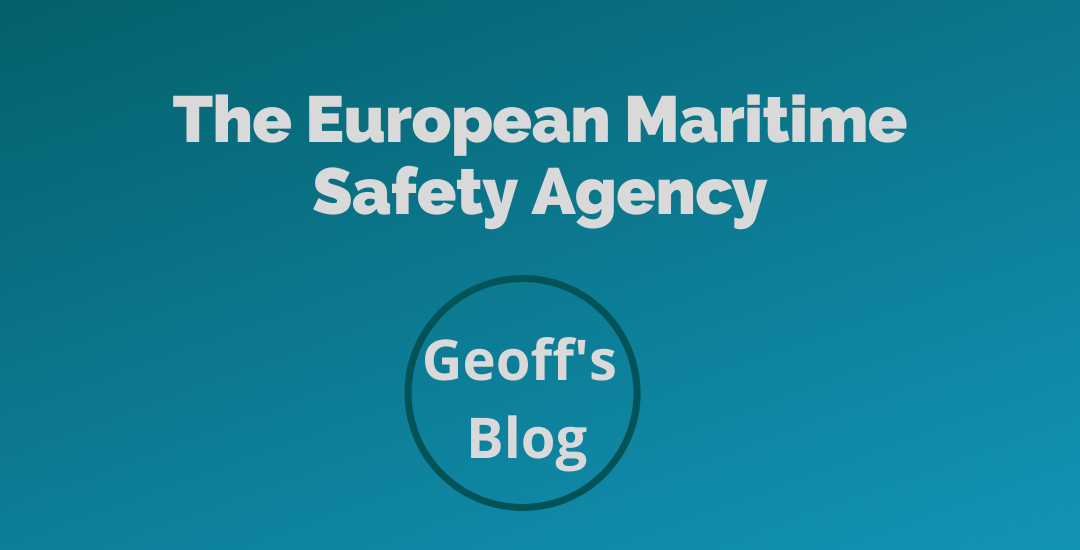- March 24, 2022
- Posted by: EARSC
- Categories: Blogs, Geoff's Blog

by Delphine Miramont
The European Maritime Safety Agency (EMSA) is an operational agency of the European Union (EU) based in Lisbon, Portugal. Founded in 2002, it focuses on maritime safety, security and pollution response (linked to human operations).
Most of the Agency’s tasks are preventive, such as monitoring how certain laws are being applied and evaluating their overall effectiveness, but some tasks are also reactive, such as providing EU countries with oil recovery ships in the event of a major spill at sea and detecting marine pollution through satellite surveillance[1].
EMSA provides governments and authorities with detailed, reliable knowledge about what happens at sea, in real time, to help them implement maritime policies effectively. EMSA also offers maritime services which respond to the changing needs of diverse maritime users across Europe: vessel reporting, integrated maritime information, pollution response or port state control.
EMSA is a service provider to the European Commission, EU Member States and some third countries. To secure a part of its operational role, EMSA is a user of satellite data and also acts as an Entrusted Entity for Copernicus Services[2]. EMSA has two main Earth Observation (EO) related services:
This service offers assistance to participating States and authorities in the following activities: vessel detection (including identification of non-reporting/non cooperative targets), feature detection, activity detection, oil spill detection, monitoring of accidental pollution in emergency situations. In the context of this service, EMSA uses mainly SAR data from Sentinel-1 but also a small amount of Optical data from Sentinel-2. The scope and extent of this service is important as 15657 images were analysed only in 2020.
–Copernicus Maritime Surveillance Service
The value-added products (i.e. Vessel detection, Activity detection as well as Wind and Wave Information) available through the Copernicus Maritime Surveillance Service allow to reach large user communities ranging from fisheries control, law enforcement, maritime safety and security, customs, marine pollution monitoring and support to international organisations (Interpol, UN…).
During our EOcafe dedicated to EMSA[3], Mrs Paula Marti (Project Officer for Earth Observation at the Agency ) showed with concrete examples how EO information, combined with a range of other maritime data, is being used in successful cases.
- Customs: In 2020, Spanish authorities had visualised three potential go-fast boats in a CMS image; they did not manage to apprehend them but forced them to throw the drugs that they were carrying into the sea where it was partially recovered by authorities.
- Maritime Safety: In January 2022, the Portuguese Navy, through its Ponta DelgadaMaritime Search and Rescue Coordination Center (MRCC Delgada) reported 30 containers fell from a vessel near Azores. Two containers were located by using satellite data on 9th January 2022 and 12 more were found in the images on 10th January 2022. Their precise location was used to recalculate the search area because they are a navigation hazard for vessels in the area.
- Fisheries Control: the European Fisheries Control Agency (EFCA) requested support to detect potential illegal activity related to Bluefin Tuna catching, transfer and transport operations. EMSA offered optical images that successfully supported the request of the EFCA.
- Marine Pollution: in July 2020, the Japanese MV Wakashio bulk carrier was grounded in the coast of Mauritius; the ship caused an oil spill that reached the nearby reefs and shore. Optical and SAR images were requested and allowed the local authorities to follow and direct the spill evolution.
Looking at the future, it is also important to highlight the importance of new technologies that will enrich the maritime services provided by the Agency. Indeed, EMSA is currently running a couple of proof-of-concept to test additional satellite capabilities[4] and integrate artificial intelligence (AI)[5]. On the long term, the objective for the Agency will be to have a centralised and automatized generation of added-value products using AI.
[1] https://european-union.europa.eu/institutions-law-budget/institutions-and-bodies/institutions-and-bodies-profiles/emsa_en
[2] This means that there is an agreement between EMSA and the European Commission to provide some of the Copernicus services.
[3] You can watch the recording of the EOcafe here
[4] For example: radiofrequency detection from space, infrared sensors, new radar and optical missions
[5] Through the development of machine learning algorithms with vessel detection and vessel clarification.
